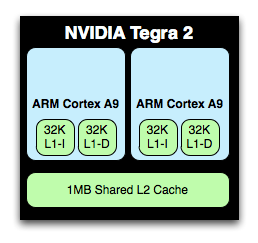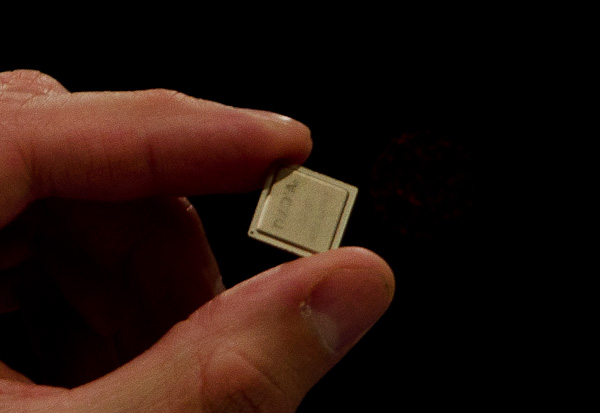NVIDIA's Project Kal-El: Quad-Core A9s Coming to Smartphones/Tablets This Year
by Anand Lal Shimpi on February 15, 2011 9:05 PM ESTThe Architecture
Kal-El looks a lot like NVIDIA's Tegra 2, just with more cores and some pin pointed redesigns. The architecture will first ship in a quad-core, 40nm version. These aren't NVIDIA designed CPU cores, but rather four ARM Cortex A9s running at some presently unannounced clock speed. I asked NVIDIA if both the tablet and smartphone versions of Kal-El will feature four cores. The plan is for that to be the case, at least initially. NVIDIA expects high end smartphones manufacturers to want to integrate four cores this year and going in to 2012.

The CPU cores themselves have changed a little bit. Today NVIDIA's Tegra 2 features two Cortex A9s behind a shared 1MB L2 cache. Kal-El will use four Cortex A9s behind the same shared 1MB L2 cache.
NVIDIA also chose not to implement ARM's Media Processing Engine (MPE) with NEON support in Tegra 2. It has since added in MPE to each of the cores in Kal-El. You may remember that MPE/NEON support is one of the primary differences between TI's OMAP 4 and NVIDIA's Tegra 2. As of Kal-El, it's no longer a difference.

Surprisingly enough, the memory controller is still a single 32-bit wide LPDDR2 controller. NVIDIA believes that even a pair of Cortex A9s can not fully saturate a single 32-bit LPDDR2 channel and anything wider is a waste of power at this point. NVIDIA also said that effective/usable memory bandwidth will nearly double with Kal-El vs. Tegra 2. Some of this doubling in bandwidth will come from faster LPDDR2 (perhaps up to 1066?) while the rest will come as a result of some changes NVIDIA made to the memory controller itself.
Power consumption is an important aspect of Kal-El and Kal-El is expected to require, given the same workload, no more power than Tegra 2. Whether it's two fully loaded cores or one fully loaded and one partially loaded core, NVIDIA believes there isn't a single example of a situation where equal work is being done and Kal-El isn't lower power than Tegra 2. Obviously if you tax all four cores you'll likely have worse battery life than with a dual-core Tegra 2 platform, but given equal work you should see battery life that's equal if not better than a Tegra 2 device of similar specs. Given that we're still talking about a 40nm chip, this is a pretty big claim. NVIDIA told me that some of the power savings in Kal-El are simply due to learnings it had in the design of Tegra 2, while some of it is due to some pretty significant architectural discoveries. I couldn't get any more information than that.

Kal-El vs. Tegra 2 running 3D game content today at 2 - 2.5x the frame rate
On the GPU side, Kal-El implements a larger/faster version of the ULP GeForce GPU used in Tegra 2. It's still not a unified shader architecture, but NVIDIA has upped the core count from 8 to 12. Note that in Tegra 2 the 8 cores refer to 4 vertex shaders and 4 pixel shaders. It's not clear how the 12 will be divided in Kal-El but it may not be an equal scaling to 6+6.
The GPU clock will also be increased, although it's unclear to what level.
The combination of the larger GPU and the four, larger A9 cores (MPE is not an insignificant impact on die area) results in an obviously larger SoC. NVIDIA measures the package of the AP30 (the smartphone version of Kal-El) at 14mm x 14mm. The die size is somewhere around 80mm^2, up from ~49mm^2 with Tegra 2.











76 Comments
View All Comments
softdrinkviking - Wednesday, February 16, 2011 - link
lolsoftdrinkviking - Wednesday, February 16, 2011 - link
Nicholas Cage's son is actually named "Kal-El." Seriously.samirsshah - Tuesday, February 15, 2011 - link
how to compete.j.harper12 - Tuesday, February 15, 2011 - link
Nvidia... I literally just committed myself to buying a new smartphone a year, despite only have a full upgrade every two years. Am I really going to have to buy a new smartphone every six months now?!? Really?!?! Not cool Nvidia... actually, pretty cool, but vicious as far as budgets go.Here I was pining over the Optimus 3D...
MrSpadge - Wednesday, February 16, 2011 - link
You know, "new stuff exists" does not equal "have to buy it" ;pMrS
medi01 - Wednesday, February 16, 2011 - link
How many gigaherzopuxelshmixels does your current phone have?How often do you have to charge it?
mesiah - Wednesday, February 16, 2011 - link
Sounds like best buys buyback plan is in your future :DAuDioFreaK39 - Wednesday, February 16, 2011 - link
Can't wait to have a 24-CPU core Nvidia Tegra mobile processor based on Iron Man architecture in 2014!! \m/bplewis24 - Wednesday, February 16, 2011 - link
Pffft, while you're buying that I'll be waiting to purchase the 32-core SoC believed to be released in Q1 2015.Gonemad - Wednesday, February 16, 2011 - link
As long you don't need an ark reactor to power it, I'm game too.If Nvidia can do SoC chips, can it do full-blown non-mobile CPUs too? Just asking... I guess it's just like nuclear arsenal: can do it in 2 years or less, have all the tools, but won't tell you if it did.